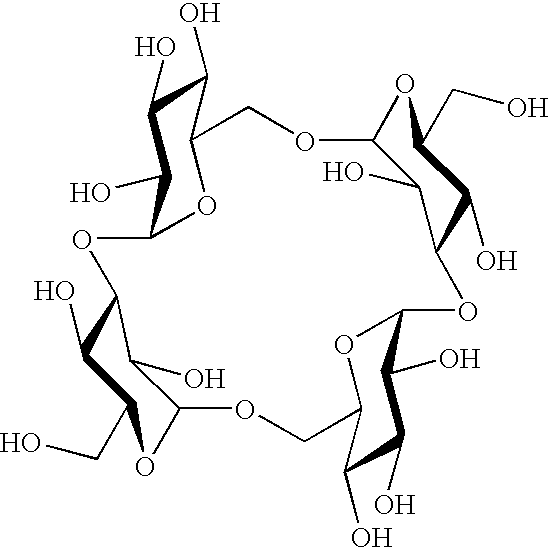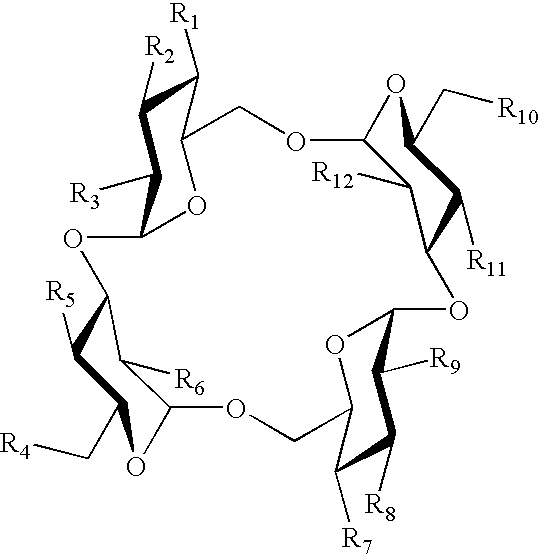Sugar derivative
a technology of sugar derivatives and sugar, which is applied in the field of sugar derivatives, can solve the problems of difficult industrial production of cyclotetrasaccharides by the above process, and achieve the effects of low caloric content, low cost and low fermentation ra
- Summary
- Abstract
- Description
- Claims
- Application Information
AI Technical Summary
Benefits of technology
Problems solved by technology
Method used
Image
Examples
example a-2
[0078] Preparation of Enzymes Originated from Bacillus globosporus C9
[0079] About 18 L of the culture supernatant obtained in Example A-1 were salted out with 80% saturated ammonium sulfate solution and allowed to stand at 40.degree. C. for 24 hours, and the formed precipitates were collected by centrifuging at 10,000 rpm for 30 min, dissolved in 10 mM sodium phosphate buffer (pH 7.5), and dialyzed against the same buffer to obtain about 400 ml of a crude enzyme solution. The crude enzyme solution had 8,110 units of .alpha.-isomaltosylglucosaccharide-forming enzyme, 24,700 units of .alpha.-isomaltosyl-transferring enzyme, and about 15,600 units of cyclotetrasaccharide-forming activity. The crude enzyme solution was subjected to ion-exchange column chromatography using 1,000 ml of "SEPABEADS FP-DA13" gel, an ion-exchange resin commercialized by Mitsubishi Chemical Industries, Ltd., Tokyo, Japan. Both .alpha.-isomaltosylglucosaccharide-forming enzyme and .alpha.-isomaltosyl-transferri...
example a-3
[0081] Purification of .alpha.-isomaltosylglucosaccharide-forming Enzyme Originated from Bacillus globisporus C9
[0082] The fractions comprising .alpha.-isomaltosylglucosaccharide-forming enzyme, obtained in Example A-2 was dialyzed against10 mM sodium phosphate buffer (pH 7.0) with 1 M ammonium sulfate. The dialyzed solution was centrifuged to remove impurities, and subjected to hydrophobic column chromatography using 350 ml of "BUTYL-TOYOPEARL 650M" gel, a hydrophobic gel commercialized by Tosoh Corporation, Tokyo, Japan. The enzyme adsorbed on "BUTYL-TOYOPEARL 650M" gel and, when eluted with a linear gradient decreasing from 1 M to 0M of ammonium sulfate, the enzyme was eluted at an ammonium sulfate concentration of about 0.3 M, and fractions with the enzyme activity were collected. The collected solution was dialyzed against 10 mM sodium phosphate buffer (pH 7.0) with 1 M ammonium sulfate again. The dialyzed solution was centrifuged to remove impurities, and purified by affinity ...
example a-4
[0083] Purification of .alpha.-isomaltosyl-transferring Enzyme Originated from Bacillus globisporus C9
[0084] The fractions comprising .alpha.-isomaltosyl-transferring enzyme, which are separated from those comprising .alpha.-isomaltosylgucosacchari-de-forming enzyme by the affinity chromatography described in Example A-2, was dialyzed against 10 mM sodium phosphate buffer (pH 7.0) with 1 M ammonium sulfate. The dialyzed solution was centrifuged to remove impurities, and subjected to hydrophobic column chromatography using 350 ml of "BUTYL-TOYOPEARL 650M" gel, a hydrophobic gel commercialized by Tosoh Corporation, Tokyo, Japan. The enzyme adsorbed on "BUTYL-TOYOPEARL 650M" gel and, when eluted with a linear gradient decreasing from 1 M to 0M of ammonium sulfate, the enzyme was eluted at an ammonium sulfate concentration of about 0.3 M, and fractions with the enzyme activity was collected. The collected solution was dialyzed against 10 mM sodium phosphate buffer (pH 7.0) with 1 M ammo...
PUM
| Property | Measurement | Unit |
|---|---|---|
| Temperature | aaaaa | aaaaa |
| Temperature | aaaaa | aaaaa |
| Temperature | aaaaa | aaaaa |
Abstract
Description
Claims
Application Information
 Login to View More
Login to View More - R&D
- Intellectual Property
- Life Sciences
- Materials
- Tech Scout
- Unparalleled Data Quality
- Higher Quality Content
- 60% Fewer Hallucinations
Browse by: Latest US Patents, China's latest patents, Technical Efficacy Thesaurus, Application Domain, Technology Topic, Popular Technical Reports.
© 2025 PatSnap. All rights reserved.Legal|Privacy policy|Modern Slavery Act Transparency Statement|Sitemap|About US| Contact US: help@patsnap.com



